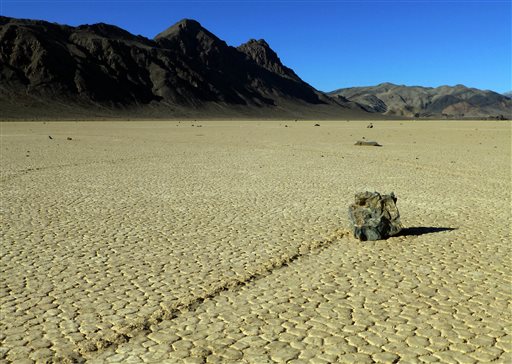Mystery of Death Valley’s moving rocks solved

This undated photo provided by the National Park Service shows rocks that have moved across a dry lake bed in Death Valley National Park in California’s Mojave Desert. AP FILE PHOTO
DEATH VALLEY NATIONAL PARK, California — For years scientists have theorized about how large rocks — some weighing hundreds of pounds — zigzag across Racetrack Playa in Death Valley National Park, leaving long trails etched in the earth.
Now two researchers at the Scripps Institution of Oceanography at the University of California, San Diego, have photographed these “sailing rocks” being blown by light winds across the former lake bed.
Cousins Richard Norris and James Norris said the movement is made possible when ice sheets that form after rare overnight rains melt in the rising sun, making the hard ground muddy and slick.
On Dec. 20, 2013, the cousins catalogued 60 rocks moving across the playa’s pancake-flat surface.
“Observed rock movement occurred on sunny, clear days, following nights of sub-freezing temperatures,” they wrote in a report published Wednesday in the online scientific journal PLOS ONE.
Article continues after this advertisementThe conclusion proves theories that have been floated since geologists began studying the moving rocks in the 1940s.
Article continues after this advertisementThe phenomenon doesn’t happen often because it rarely rains in the notoriously hot and dry desert valley.
The rocks move about 15 feet (5 meters) per minute, according to the report.
Richard Norris, 55, a paleobiologist at Scripps, and James, 59, a research engineer, launched their “Slithering Stones Research Initiative” in 2011, the Los Angeles Times reported (https://lat.ms/VNVWou).
After getting permits from the National Park Service, they installed a weather station in the area and placed 15 stones equipped with global positioning devices on the playa.
The “GPS stones,” which were engineered to record movement and velocity, were stationed at the southern end of the playa where rocks begin their strange journeys after tumbling down a cliff.
At the end of last year, Richard and James Norris returned to inspect the instruments.
“We found the playa covered with ice,” Richard recalled to the Times. “We also noticed fresh rock trails near shards of thin ice stacked up along the shoreline.”
The following afternoon, “we were sitting on a mountainside and admiring the view when a light wind kicked up and the ice started cracking,” he said. “Suddenly, the whole process unfolded before our eyes.”